30 Effective Time Management Techniques for Work and Life
Are you a project manager searching for ways to improve your and your team’s efficiency?
Here are the 30 most effective time management methods you can use to improve productivity and project estimations.

What are time management techniques?
Time management techniques are a set of rules and principles you need to follow to:
- Be more productive and efficient with your time,
- Make better and faster decisions, and
- Accomplish more in less time and with less effort.
There are plenty of time management hacks based on approved time management best practices, like:
- Writing down what you need to do today,
- Working on important and urgent tasks first,
- Tracking project progress and identifying lags,
- Taking breaks, and
- Avoiding stress and burnout.
Comparison of the best time management methods
We’ve analyzed 30 best time management techniques, and here’s a brief comparison.
| Time management method | Issues it solves | Especially useful for |
|---|---|---|
| Pomodoro Technique | Inability to focus Skipping breaks |
Better time estimates for your work |
| Kanban Technique | Multitasking Missed deadlines |
A straightforward representation of your progress with a project |
| Getting Things Done | Ineffective scheduling Difficulty setting priorities |
Personal and professional productivity |
| Eat That Frog | Ineffective scheduling Multitasking |
Priority tasks |
| Timeboxing | Missed deadlines Skipping breaks |
A large number of small tasks |
| Time blocking | Skipping breaks Multitasking |
Better task scheduling |
| Inbox Zero | Ineffective scheduling Multitasking |
Email management |
| Who's Got the Monkey | Inability to delegate tasks Multitasking |
Managers and anyone who delegates tasks |
| The Action Method | Ineffective scheduling Multitasking |
A straightforward representation of your progress with a project |
| The Eisenhower Matrix | Missed deadlines Distractions |
Priority tasks |
| Biological Prime Time | Ineffective scheduling Missed deadlines |
Organizing your day according to energy levels |
| The Productivity Journal | Difficulty tracking productivity Inability to stay organized |
An overview of personal and professional activities |
| The Seinfeld Method | Missed deadlines Problem with accomplishing goals |
Long-term productivity |
| The 7-8-9 Rule | A lack of work-life balance Burnout |
Well-being |
| The 6-12-6 Rule | Ineffective scheduling Multitasking |
Email management |
| The 10-Minute Rule | Procrastination Multitasking |
Smaller tasks |
| To-Done List | Ineffective scheduling A lack of motivation |
An overview of how much you’ve accomplished so far |
| To-Don't List | Ineffective scheduling Distractions |
Self-discipline |
| Flowtime Technique | Multitasking Inability to focus |
Longer deep-work sessions |
| Top Goal | Multitasking Distractions |
Long-term goals |
| Pareto Analysis | Multitasking Scattered focus |
Work or private issues |
| Rapid Planning Method (RPM) | Multitasking Problem with accomplishing goals |
Long-term goals |
| Pickle Jar Theory | Ineffective scheduling Distractions |
Priority tasks |
| Deep Work Method | Multitasking Solving demanding tasks |
Focus on vital tasks |
| The ABCDE Method | Missed deadlines Inability to delegate tasks |
Priority tasks |
| The 1-3-5 Rule | Ineffective scheduling Difficulty setting priorities |
Balanced daily to-do lists |
| The POSEC Method | A lack of work-life balance Difficulty setting priorities |
Short and long-term goals |
| The Bullet Journal (BuJo) Method | Missed deadlines A lack of work-life balance |
Long-term goals |
| The 3-2-1 Rule | A lack of work-life balance Burnout |
Well-being and focus |
| The 60-40 Rule | Burnout Spending too much time doing less important tasks |
Long-term goals |
Best time management techniques
If you’re not sure how to improve time management, here are the 30 most effective methods you can try.
1. Pomodoro Technique
Pomodoro is one of the most popular focus and concentration techniques. It involves parsing work into 25-minute intervals (pomodoros) separated by 5-minute breaks.
Developed by Francesco Cirillo, the Pomodoro technique takes its name from the Pomodoro-shaped kitchen timer Francesco used to track his work progress.
How the Pomodoro Technique works:
- Set your timer for 25 minutes,
- Focus on your work during these 25 minutes,
- Stop working as soon as the alarm goes off,
- Take a 5-minute break,
- Resume work for another 25 minutes,
- After four 25/5 minute cycles, take a 20-minute break, and
- Repeat the process until you finish your task or project.

For this purpose, you can use Clockify’s Pomodoro timer and track your work sessions and breaks directly from your device.
🎓 Getting Started With the Pomodoro Technique
Advantages of the Pomodoro Technique:
- Regular breaks help eliminate burnout and improve performance.
- Helps in overcoming procrastination — knowing you only have to work for 25 minutes makes a demanding task more achievable.
- Boosts motivation — you’ll feel a sense of accomplishment after each completed work interval.
Disadvantages of the Pomodoro Technique:
- You have to stop working once the 25 minutes run out — if you’re doing particularly well, this is counterproductive.
- Maintaining consistent 25/5-minute cycles may not always be possible, especially if your workday is filled with urgent meetings and requests.
2. Kanban Technique
A visual time management method that helps you follow the progress of your projects — you track how the tasks move across differently labeled columns.
This technique was first introduced in the 1940s by Taiichi Ohno, a Toyota engineer from Japan.
How the Kanban Technique works
You can use project management software, a pen and paper, or a whiteboard and sticky notes.
Determine the number of stages in your project, and create the columns. For example, you can create 4 columns and move tasks within a project across these stages:
- Backlog — you brainstorm and define your tasks here. Then you decide which tasks you’ll move to the To Do column, and which can wait for their turn.
- To Do — the tasks you’ll work on.
- In Progress — the tasks you’re currently working on.
- Done — the tasks you’ve finished.
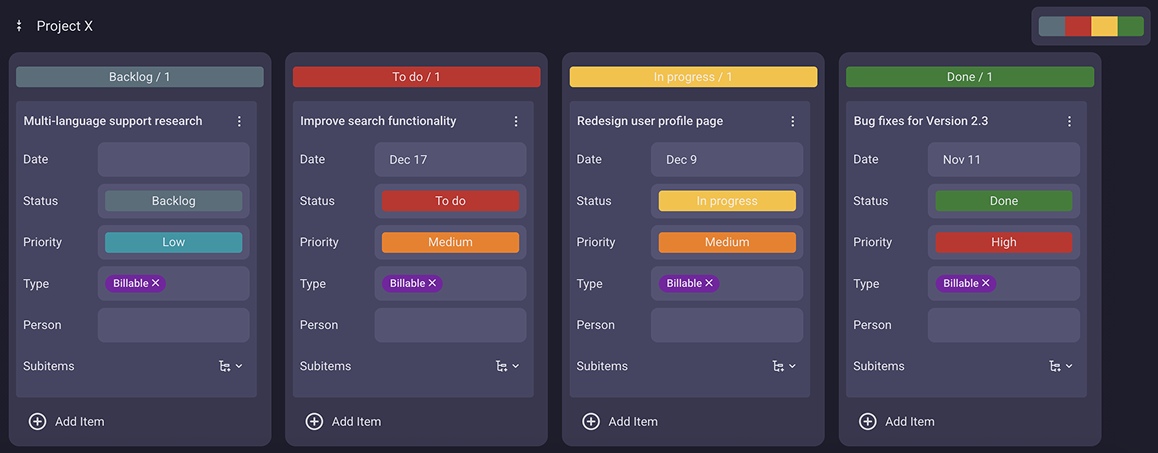
A marketing agency owner, Mandy Hoskinson, and her team find Kanban effective for tracking their remaining work:
As a manager, she loves seeing the ‘Done’ column fill up.
Advantages of the Kanban Technique:
- Helps you manage workload — you can break the project into small, manageable tasks and track their progress across the board.
- The team is likely to focus on progressing with their tasks to reach the “Done” column.
- Provides a visual representation of all your tasks and their statuses, enabling greater transparency.
Disadvantages of the Kanban Technique:
- No one-size-fits-all template — creating a Kanban board can be time-consuming, as you have to decide how many columns to include and how to name them.
- It may be difficult to predict when your team will finish the tasks (and the project) because the only measure of progress is moving across columns — there’s no time component.
3. Getting Things Done
A 5-step method that allows you to brainstorm your tasks and make them into a straightforward to-do list.
Getting Things Done (GTD) was introduced by David Allen in his book Getting Things Done: The Art of Stress-Free Productivity.
🎓 Make the Most Out of Getting Things Done (GTD) Method
How Getting Things Done works:
- Capture — note every task that springs to mind.
- Clarify — determine whether the task has concrete steps you can follow.
- Organize — file tasks under different labels and provide them with context (e.g., home, office, request from Tom).
- Reflect — from time to time, review your tasks: What’s the next step for the task? Do you really need to finish it this week?
- Engage — start working on your tasks.
Advantages of Getting Things Done:
- Offers a systematic approach for determining “next actions,” enabling improved decision-making.
- You’ll clear your head once you lay out every task you can think of.
- You can use GTD to boost both your personal and professional productivity.
Disadvantages of Getting Things Done:
- You have to use your willpower to progress with your work — GTD doesn’t provide guidelines for dealing with distractions.
- Task organization happens by context, not by project, which may be unhelpful if you’re used to parsing tasks in relation to their project.
4. Eat That Frog
You pick your most important or unpleasant task — your “frog” — and tackle it first thing in the morning. Once you’ve finished with your “frog,” you can move on to other tasks for the day, but not before.
This may be a task you’ve been avoiding because it’s boring or demanding.
The “Eat That Frog” premise was developed by Brian Tracy in his book Eat That Frog!: 21 Great Ways to Stop Procrastinating and Get More Done in Less Time.
🎓 “Eat the Frog” to Boost Your Productivity
How Eat That Frog works
You have to identify tasks based on their priority, and label them accordingly:
- Task A — the most important task; the one you should tackle first, or suffer the consequences.
- Task B — the second most important task, the one you should tackle after Task A. Less important, but still vital.
- Task C — a task you could do, but you wouldn’t suffer consequences if you didn’t do it.
- Task D — a task you should ideally delegate to someone else, and allocate this time to Task A.
- Task E — a task you don’t really need to do, so you’re free to eliminate it.
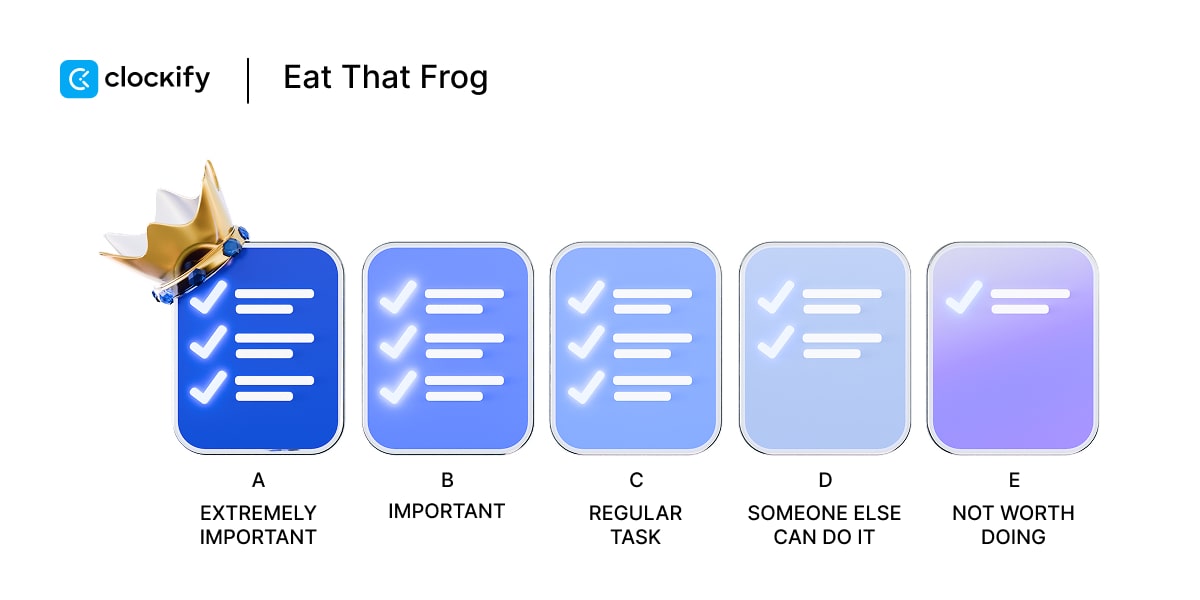
Advantages of Eat That Frog:
- Helps you improve task prioritization.
- Doing the most demanding task first thing in the morning makes the rest of your daily schedule easier to accomplish. This will motivate and energize you.
- Minimizes multitasking by requiring you to focus on a single, most challenging task.
Disadvantages of Eat That Frog:
- A difficult start to the day.
- May be rigid and impractical if your most important task changes during the course of the day.
5. Timeboxing
Timeboxing is the practice of allocating time periods (or timeboxes) to tasks. In short, you work within this period and stop once the set time is up. Timeboxing often involves fixed deadlines, which is why it’s often used in project management.
James Martin was the first to explain the technique in more detail, in one of the chapters of his book Rapid Application Development.
🎓 Timeboxing: Definition, Benefits, and Best Practices
How timeboxing works:
- Lay out all your tasks on a list.
- Decide what you want to accomplish with these tasks — define your goals.
- If a task is important and requires intense focus, allocate more time to it (e.g., 1 or 2 hours).
- If it’s a difficult assignment, parse it and allocate shorter time periods (e.g., 20-30 minutes) to parts of the task to make it manageable.
- Start from your first task, and work your way down.
- When the allocated time for a task is up, stop working on it.
- Take a break.
- Review what you’ve accomplished.
- Turn your attention to other timeboxes in your schedule.

Advantages of timeboxing:
- Great for a large number of small tasks — it’ll be easier to keep track of them and tackle them, once you have them laid out in timeboxes.
- Natural perfectionists will have less time to tweak every detail, as they’ll have to move on to the next task in the schedule.
- Completing each timeboxed task gives you a sense of satisfaction and boosts your motivation.
Disadvantages of timeboxing:
- You have to stop working on a task when the time for it expires. This can be counterproductive when you’re creatively engaged and don’t want to break your momentum.
- Your timeboxing calculations may be off. Too short timeboxes — you may have to stop before you’re even immersed in a task. Too long timeboxes — you may start procrastinating to pass the time until the end of the timebox.
6. Time blocking
Time blocking is one of the best scheduling techniques. It involves reserving time for tasks to ensure each task has a place in your day.
🎓 The Ultimate Time Blocking Guide (+ Time Blocking Apps)
How time blocking works
Time blocking includes 4 stages:
- Planning stage: define your tasks and activities, and identify priorities.
- Blocking stage: assign each task with a specific time block — with specific days and start and end times noted in your calendar. The time block can be shorter (e.g., 10 minutes) or longer (e.g., 90 minutes) for priority tasks.
- Acting stage: start working on the first daily task and schedule breaks between time blocks to reset your focus. If you receive an urgent task, block an appropriate amount of time for it and start working on it as soon as possible.
- Revision stage: if you see a task takes longer or shorter than you estimated, revise the schedule for other tasks you’ve planned for that day.

Time blocking helps Landon Murie, the founder of a digital marketing agency, ensure he has dedicated time for high-priority work:
Advantages of time blocking:
- Supports deep work, as you have to stick to a fixed schedule for when you’ll focus on a task.
- You’ll have better control of your workload.
- Scheduling a specific time for a task helps improve accountability.
Disadvantages of time blocking:
- Unexpected interruptions may disrupt your schedule.
- Your time calculations may be off — you may procrastinate while waiting for a too-long time block to end or rush to beat the time during a too-short time block.
7. Inbox Zero
This is an approach to managing your email inbox: aim to keep it empty or nearly empty.
The Inbox Zero method was developed by Merlin Mann, a productivity expert and writer.
How Inbox Zero works
To reach inbox zero, you have to:
- Determine the time of day you’ll work on managing your inbox — stick to this time.
- Silence notifications and don’t leave the email tab open in your browser.
- Prioritize your emails — respond right away to emails you can answer quickly. Move emails that’ll take you longer to answer to a “needs a response” folder (allocate some of your “manage inbox” time to these responses). Decide what messages you can delegate and forward them to other team members. Delete and archive unwanted or old messages.
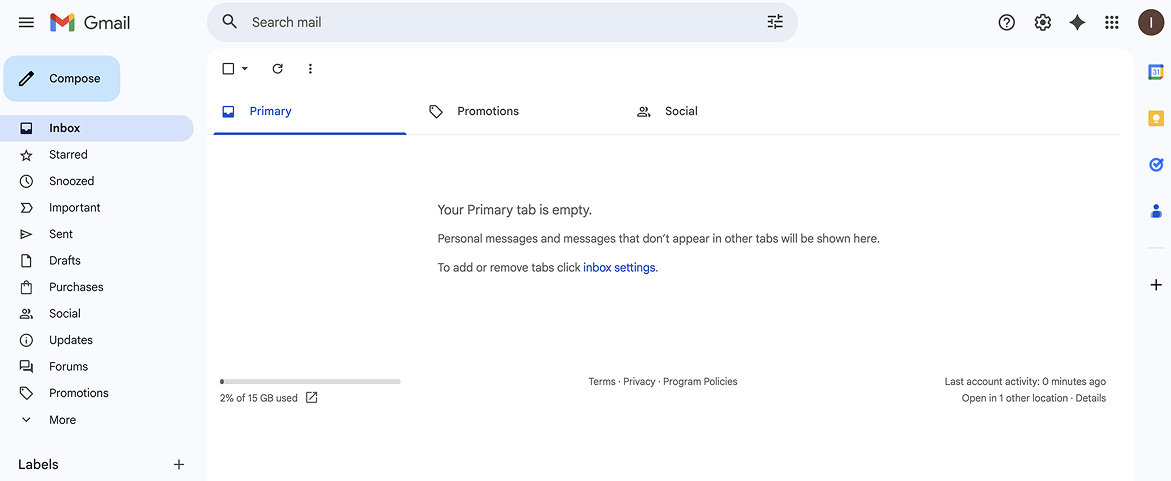
Advantages of Inbox Zero:
- Decreases the number of unread messages, those that stop you from finding your important emails.
- Focuses on allocating inbox management only to a specific part of the day — you won’t be distracted by emails throughout the day.
- Reduces mental load from email clutter.
Disadvantages of Inbox Zero:
- Time-consuming, since you have to forward, archive, and delete many messages.
- Only deals with inbox management — you’ll have to combine it with other time management techniques that focus on managing tasks and projects.
8. Who’s Got the Monkey
Who’s Got the Monkey emphasizes delegating tasks, so it’s primarily aimed at project managers — although others can also benefit. Monkeys are tasks, and you have to consider how to deal with them.
There are 3 types of “monkeys” and managed time:
- Boss-imposed time — activities your boss required.
- System-imposed time — peers’ requests and questions.
- Self-imposed time — the actions you decide to undertake. You may use it for your own tasks and ideas (discretionary time), or to tackle subordinates’ problems and requests (subordinate-imposed time).
You aim to minimize subordinate-imposed time, control system-imposed and boss-imposed time, and increase discretionary time.
The principle is based on William Oncken Jr.’s book Managing Management Time: Who's Got the Monkey?.
How Who’s Got The Monkey works:
- Recognize and describe the “monkey”— identify the task and specify what needs to be done.
- Assign the “monkey” — allocate the task to a person.
- Determine the level of initiative for the “monkey” — if a task is important, the person assigned to it recommends an action plan, and you approve it before they proceed. If a task is lower-risk, the person assigned to it takes action and informs you of the results afterward.
- Check on the “monkey” — specify when you’ll provide follow-up for the monkey, to make sure everything is on track.

Advantages of Who’s Got the Monkey:
- Managers can use their time more effectively.
- Encourages employees to take the initiative and feel more responsible for their tasks.
- Ensures clear team communication by defining task ownership and expectations.
Disadvantages of Who’s Got the Monkey:
- Deals only with task delegation — it should be combined with other time management methods for better overall productivity.
- If a task is incorrectly categorized as low-risk, it may cause delays.
9. The Action Method
The Action Method is based on the premise that everything is a project — you view all your activities as projects and parse and manage them accordingly.
How the Action Method works
You break down your project into 3 categories:
- Action steps — the tasks that you need to complete, those that move a project forward.
- References — notes, links to relevant resources, and outlines that help you tackle your Action steps.
- Backburner items — ideas and plans you’re not currently working on, but may put into motion someday.

Advantages of the Action Method:
- Keeping all supporting information in one place helps reduce the time spent on digging through files to find what you need.
- Helps you focus on your current priorities by separating immediate tasks from ideas for later.
- Offers a structured approach for effective task management.
Disadvantages of the Action Method:
- Time-consuming and potentially overwhelming — viewing everything as a project means you’ll spend a lot of time planning.
- No schedule for reviewing backburner items — no clarity on when you should tackle these items.
10. The Eisenhower Matrix
This is one of the most popular time management methods for task prioritization. The Eisenhower Matrix is based on labeling each task as:
- Important/not important, and
- Urgent/not urgent.
The Eisenhower Matrix is named after the American president Dwight D. Eisenhower, who was known for his productivity during his time in office.
🎓 Eisenhower Matrix – Prioritize and Manage Time Better
How the Eisenhower Matrix works
List all your tasks, and divide them into 4 quadrants:
- 1st quadrant — tasks that are important and urgent. You should do them immediately.
- 2nd quadrant — tasks that are important, but not urgent. You should make a plan for when you’ll tackle them.
- 3rd quadrant — tasks that aren’t important, but are urgent. You should delegate these tasks to your team members.
- 4th quadrant — tasks that are neither important nor urgent. You should eliminate them from your schedule.

Founder of a growth marketing firm, Peter Murphy Lewis, says the Eisenhower Matrix allows him to use his time and energy more effectively:
Advantages of the Eisenhower Matrix:
- Helps you reduce time wasted on low-value tasks.
- By clearly sorting your tasks, you’ll gain better control over your workload and reduce stress.
- Can be implemented quickly — it doesn’t require extensive preparation.
Disadvantages of the Eisenhower Matrix:
- It may be difficult to determine the importance and urgency level of tasks.
- Present bias may stop you from fully adopting this technique — you’ll feel an urge to focus on urgent tasks that aren’t necessarily important.
🎓 Present Bias: How to Overcome It to Pursue Your Future Goals
11. Biological Prime Time
Your biological prime time is the time of day when you have the highest energy levels, so you’re most likely to be productive with your work.
Once you determine your biological prime time, you’ll be able to allocate your most important tasks to this time.
The term “Biological Prime Time” was first introduced by Sam Carpenter in his book Work the System: The Simple Mechanics of Making More and Working Less.
How Biological Prime Time works:
- Experiment with your work across a longer period (e.g., 20 days).
- Track your energy, motivation, and attention span over these days — within a fixed time period (e.g., from 9 a.m. to 5 p.m. every day).
- Chart your results every hour and every day.
- After 20 days, analyze your results — you’ll notice that a certain time of day stands out as the time when you were able to get the most work done.
- Once you’ve identified your most productive hours of the day, allocate your future priority tasks to this time.
- Allocate less important tasks to the time periods you’ve noticed that your focus, motivation, and energy levels are low.

Advantages of Biological Prime Time:
- Knowing your energy peaks helps you create a sustainable schedule.
- Working on high-effort tasks when you’re most alert helps reduce procrastination and increases your efficiency.
- Aligning work with your natural energy levels helps reduce stress.
Disadvantages of Biological Prime Time:
- To identify your biological prime time correctly, you’ll need to tweak your routine often and track it over a longer period.
- If you’re subordinate to someone and have to stick to deadlines, knowing your prime biological time won’t be of use — you’ll have to work according to your boss’s requests and deadlines.
12. The Productivity Journal
The Productivity Journal is similar to a regular journal — the main difference is that instead of personal thoughts, you mostly write down your work activities. You can note in your ideas and work thoughts, the tasks you’ve finished today, and the tasks you’re supposed to tackle tomorrow.
How the Productivity Journal works:
- Each day, define your to-do list in a notebook or appropriate software — keep the items simple, clear, and achievable.
- Track the time it takes you to finish each item — you can use Clockify for this purpose and store items from your to-do list as time entries.
- Analyze your time results and tweak your future to-do lists accordingly.
For more details, you can also:
- Break each item on your to-do list into smaller, more manageable tasks.
- Set goals for the tasks or groups of tasks you wish to accomplish.
- Reflect on your day by jotting down comments on what tasks you’ve accomplished, what issues you’ve encountered, and whether you were able to overcome them.
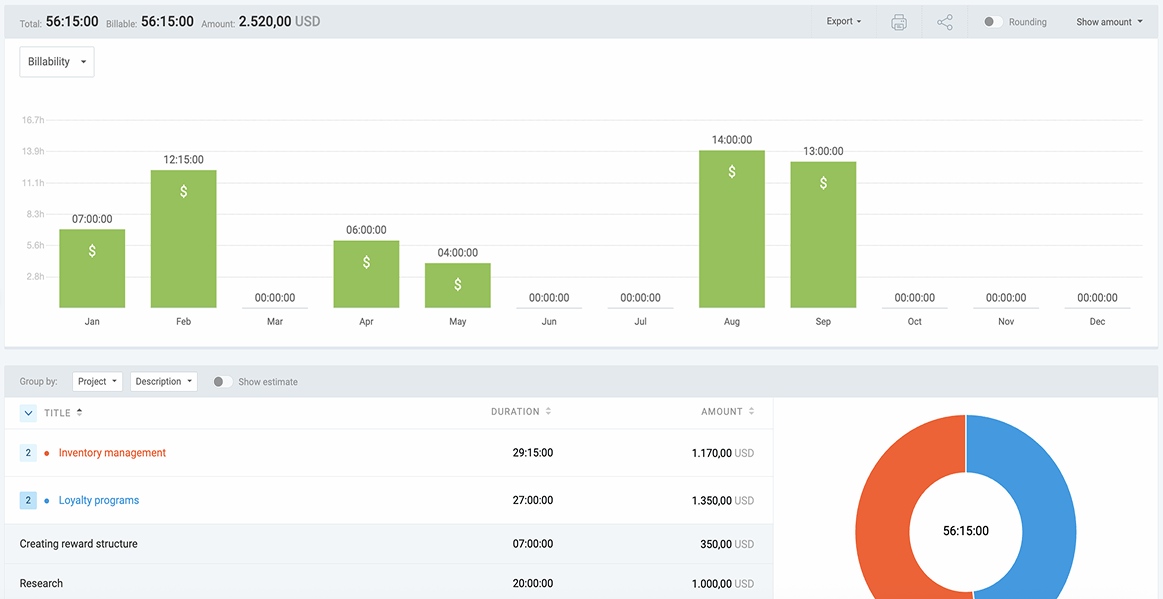
Advantages of the Productivity Journal:
- Holds your entire productivity history — you’ll have all your ideas and to-dos in one place.
- Enhances goal tracking.
- Writing down your issues can reduce stress.
Disadvantages of the Productivity Journal:
- How well-structured the journal will be depends on your ability to frame it, as there are no clear rules for this.
- There’s a risk of over-reflection — spending too much time analyzing your results can lead to procrastination.
13. The Seinfeld Method
Also known as the “Don’t Break the Chain” method, this technique helps you maintain steady progress toward a goal by taking actions every day.
Each day you take an action, mark it on your calendar, and watch the chain of consistency grow.
🎓 Don’t Break the Chain: A Productivity Technique for Building Good Habits
How the Seinfeld Method works
For example, say your goal is to improve resource planning skills — to reach this goal, follow the steps bellow:
- Get a red marker and a physical calendar.
- Each day you work on your goal (e.g., by reviewing the project scope), you mark that day with the red marker.
- The days marked red continue to grow as you review each day, forming a chain.
- If you miss a day of reviewing, you don’t mark that day with red, and you “break the chain.”
- Review the project scope each day so you “don’t break the chain.”

Advantages of the Seinfeld Method:
- Watching the chain of red days grow will motivate you to keep the chain going and work on your goal every day.
- It’s straightforward and requires little preparation.
- Helps you build good habits.
Disadvantages of the Seinfeld Method:
- The need to avoid “breaking the chain” can create pressure and result in demotivation if a day is missed.
- Some days, it’ll be hard for you to find time for your work (due to other priorities and obligations), so you may have to “break the chain.”
14. The 7-8-9 Rule
The 7-8-9 Rule helps you balance your day. It involves dividing a day into 3 key parts — sleep, work, and personal time.
How the 7-8-9 Rule works
You divide your day (24 hours) by dedicating:
- 7 hours to sleep — allocating at least 7 hours to sleep improves working memory and ensures peak cognitive performance.
- 8 hours to productive work — use this time to work on tasks, projects, and your professional development. Make sure to take short breaks in between tasks to stay focused.
- 9 hours to personal activities — use this time to pursue hobbies, exercise, rest, or be with your family and friends.
Advantages of the 7-8-9 Rule:
- Strictly separating work from personal time helps reduce stress and improve productivity.
- It’s a simple framework to help you organize your day.
- Dedicating time to hobbies helps improve job satisfaction and performance.
Disadvantages of the 7-8-9 Rule:
- The fixed 8-hour work time isn’t feasible for people who need to work longer hours.
- It doesn’t provide guidelines for managing your work responsibilities, so you’ll have to combine it with other time management methods.
15. The 6-12-6 Rule
The 6-12-6 Rule helps project managers prevent emails from consuming their entire workday. Instead of constantly checking your inbox, you do it 3 times a day at specific times.
The 6-12-6 Rule was developed by Kathryn McKinnon, a time management expert and author.
How the 6-12-6 Rule works
You check your email 3 times a day, at:
- 6 a.m.,
- 12 p.m., and
- 6 p.m.
Each time you open your inbox, you spend 20 minutes handling emails. This time limit ensures you stay efficient and have more time for your priorities.
Advantages of the 6-12-6 Rule:
- It’s easy to implement.
- It helps you minimize distractions and get the important work done.
- By dedicating blocks of time to email, you’ll minimize context switching and avoid cognitive overload.
Disadvantages of the 6-12-6 Rule:
- There’s a chance of missing urgent messages that may require your immediate attention.
- It requires self-discipline — you have to resist the urge to peek at your inbox outside of set times.
16. The 10-Minute Rule
You tell yourself you'll work on a task for 10 minutes. After 10 minutes, you decide whether to stop or keep going.
How the 10-Minute Rule works:
- Select a task.
- Start working on it immediately.
- After 10 minutes have passed, reflect on your focus and patience: do you want to stop working on the task, or do you wish to continue for 10 more minutes?
- Work for 10-minute time periods until you want to stop working on this task for the day.

Advantages of the 10-Minute Rule:
- Since 10 minutes go by quickly, chances are you'll continue working for more 10-minute sets after the first one.
- Overcoming procrastination — you'll make it a habit to dive right into work.
- Less chance for multitasking.
Disadvantages of the 10-Minute Rule:
- Stopping every 10 minutes to consider whether you're up for another 10 minutes of work can get distracting, especially if you're immersed in a task.
- Since 10 minutes isn’t enough to achieve deep focus, this method won’t be effective for tasks that require deep work (unless you extend the task beyond 10 minutes).
17. To-Done List
Instead of listing what you need to do, you list your accomplishments and the tasks you've finished so far, within a certain time period.
How To-Done List works:
- At the end of each workweek, take 10-15 minutes to note down everything you've accomplished.
- Next to each item, include what you've learned while working on it.
- For each item, note what you could do differently next time to improve your results.
Advantages of the To-Done List:
- Gives you a perspective on the amount of work you've done and the amount of work you have left to do.
- It's motivating to see how much you've accomplished in a given period.
- Over time, you’ll learn to schedule more effectively.
Disadvantages of the To-Done List:
- Knowing what you've finished so far gives you a general idea of the amount of work you have for the upcoming period, but you get no details — no set deadlines, no specific number of tasks and projects.
- When you have a lot on your plate, writing a To-Done List can seem unproductive, since you’ll probably benefit more from making a to-do list for upcoming tasks.
18. To-Don't List
A contrast to the classical To-Do List — the To-Don’t List method requires you to list all the tasks and activities you won't do.
How To-Don’t List works:
- You make a list before each workday.
- Note in all the tasks, ideas, and habits you'll aim NOT to do, or think about. These can be distractions, overly ambitious ideas you objectively have no time to work on, or bad habits you want to quit.
- Include the word “Don't” in front of each listed item.
- Cross over each item at the end of the day if you've managed to avoid it.

Advantages of To-Don’t List:
- By listing all the activities you'll no longer focus on, you’ll mentally let go of them and free more time for important matters.
- Keeps you in check regarding your bad habits, such as spending time on social media when you should be working.
- By learning what activities to avoid, you’ll get better at scheduling vital tasks.
Disadvantages of To-Don’t List:
- Gives no specifications on the tasks you should do.
- Can be hard to follow if to-don'ts aren't specific.
19. Flowtime Technique
The Flowtime Technique is based on the Pomodoro Technique, but it's less rigid about time for work sessions and breaks. This time management hack was developed by software engineer Dionatan Moura in 2015.
How the Flowtime Technique works:
- Select a task.
- Dedicate a certain amount of time (for example, 30 minutes), and set the timer.
- Work until the timer stops.
- Consider whether you can focus on the task for a few more minutes. For example, if you find you can focus for 10 more minutes, set the alarm to 10 minutes.
- When the 10 minutes expire, ask yourself whether you can maintain your focus for longer.
- At any point, when a given time period expires (after 30 minutes or after an additional 10 minutes), take a break if you find you can't focus any longer.
You can start the timer in Clockify as soon as you start working. Stop the timer to see how much time you’ve spent on this work session. When you feel you need a break, stop working.

Advantages of the Flowtime Technique:
- You get the benefits of Pomodoro's work sessions/break time routine, plus more freedom to decide how long the work sessions and breaks will last.
- By using a time tracker to see when you're most productive, you’ll know when you’re able to focus the longest.
- You’ll avoid multitasking.
Disadvantages of the Flowtime Technique:
- No prescribed time for the length of work sessions may lead you to forget about breaks and risk burnout.
- Parsing tasks is entirely up to you — you may prove unsuccessful in parsing them into manageable chunks.
20. Top Goal
Top Goal requires that you identify your most important goal and allocate time each day to work on it specifically. Author Greg McKeown clarified the concept in his book, Essentialism: The Disciplined Pursuit of Less.
How Top Goal works:
- You pick your Top Goal.
- Schedule 2 hours a day to work on it.
- It’s best that you schedule these 2 hours for the early part of the day, when you feel rested.
- Stick to the schedule.
- Avoid social media, YouTube, and other distractions during this time.
- Only work on your Top Goal during these 2 hours.
- Leave the rest of the day for other activities.

Advantages of Top Goal:
- By working on a task continuously for 2 hours, you practice your deep work capabilities.
- You're likely to make significant progress on the tasks that lead to your top goal, as you’ll allocate time specifically to them each day.
- You’ll prevent multitasking.
Disadvantages of Top Goal:
- When just starting out, 2 hours of focused work may be too much to handle.
- In contrast, seasoned practitioners may find 2 hours too short, yet they’re only allowed to work on their top goal within this fixed time frame.
21. Pareto Analysis
The gist of the Pareto Analysis (also known as the 80/20 rule) — developed by the Italian economist Vilfredo Pareto — is that 20% of our actions account for 80% of outcomes.
The idea behind this time management hack is to identify your key activities — the 20% that make a difference — and focus on them. This way, you’ll be able to achieve as much as 80% of your desired outcomes.
How Pareto Analysis works:
- Note down all the problems you’re facing. For example, you can’t seem to finish your tasks on time.
- Find the cause of this problem. You may discover that you get easily distracted while working, which is why you don’t complete tasks before the deadline.
- Assign a score (a number) to each problem — give higher numbers to more important problems. For example, you can use numbers from 1 to 10 to assign a score to your issues. Your most important problems should be labeled with the number 10, and your least important issues should be labeled with the number 1.
- Batch your problems by cause. For instance, group all your problems caused by spending too much time chatting with colleagues.
- Assign a score to each group of problems. The groups with the highest score are the ones you need to solve first.
- Get to work.

Advantages of Pareto Analysis:
- It helps you improve your problem-solving skills — with Pareto, you group similar issues together, making them easier to solve.
- You’ll get better at scheduling.
- A great method for learning how to single-task.
Disadvantages of Pareto Analysis:
- This method relies only on your past activities — your performance so far and the issues you had in the past.
- Scoring may be inaccurate — if you make a mistake by assigning higher scores to some less important issues, you might neglect other, more important problems.
22. Rapid Planning Method (RPM)
One of the best time management methods is the Rapid Planning Method (RPM), which stands for “result, purpose, and massive action plan.”
The idea behind this method is to train your brain to envision what you want so it becomes real. Created by motivational speaker Tony Robbins, this technique is practical for setting long-term goals.
🎓 How I Improved My Time Management Skills Using the Rapid Planning Method (RPM)
How the Rapid Planning Method works
First, note down all the assignments you need to complete this week. Be realistic — write down 5 to 9 tasks for the week.
Then, group similar tasks together. You can use categories such as “Work tasks,” “Non-work tasks,” “Career,” “Health,” etc.
Make your own RPM blocks — focus on your most important area and create an RPM block for it. Let’s say that this week, you’d like to focus on “Career.” Use a piece of paper, and create 3 columns:
- Results — think about the results you’d like to accomplish in this area. For example, you want to improve your public speaking skills.
- Purpose — why do you want to achieve this result? For example, you want to overcome your fear of public speaking because you’d like to be more confident in client meetings.
- Massive Action Plan — think about the activities that will help you complete the task and achieve the desired results. For example, you can find relevant public-speaking courses and finish 1 course by the end of the week.
Next, create another RPM block for your “Non-work tasks” and other categories for this week.
Finally, review your work by questioning yourself:
- Did I follow all the steps from my massive action plan?
- Did my purpose act as a motivation to help me achieve the desired results?
- Did I accomplish the desired results?
🎓 Motivation Guide: How to Get and Stay Motivated

Advantages of the Rapid Planning Method:
- This method allows you to think about your long-term goals and align them with short-term targets.
- It helps you envision your goals, understand their purpose, and write down the steps to accomplish them.
- You’ll avoid multitasking.
Disadvantages of the Rapid Planning Method:
- It’s time-consuming to plan all your weekly activities, create blocks, and review your results.
- It’s not practical for recurring tasks or tasks that require team effort.
23. Pickle Jar Theory
If you’re searching for some practical time management techniques for work, the Pickle Jar Theory might be a great fit for you.
The key advantage of using the Pickle Jar Theory is that it helps you distinguish between useful and useless tasks in your schedule. This way, you’ll be able to set priorities clearly and plan your assignments.
How Pickle Jar Theory works
The goal of this technique is to imagine a jar that contains sand, pebbles, and rocks. Here’s the meaning of each element:
- Sand: tasks and activities that usually disturb you during the day, such as emails, social media, and phone calls.
- Pebbles: important assignments that should be completed, but someone else can tackle them, or you can complete them some other day.
- Rocks: your significant tasks, and you have to complete them by the end of the day.
So, when planning your day, think about your tasks:
- Categorize them by importance — figure out which ones are rocks, pebbles, and sand.
- Make a to-do list by focusing on rocks first since these are your most significant assignments for the day.
- Write down time estimates for each task. The total amount of time should be up to 8 hours.
- If you still have some time to tackle your tasks from the “pebbles” and “sand” categories, now is the time to complete them.
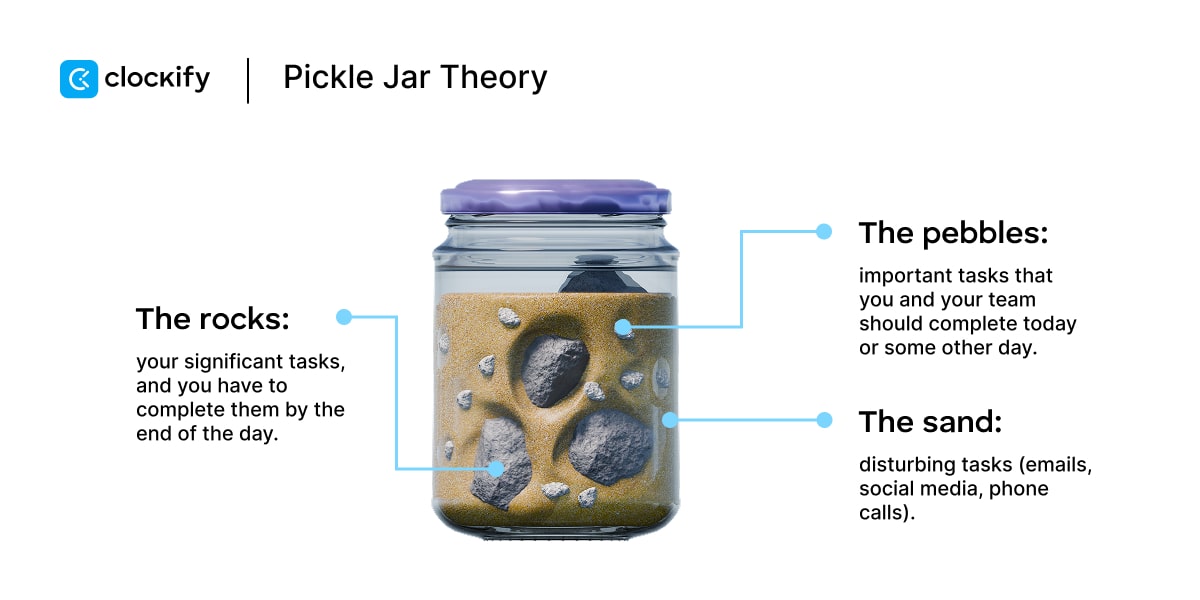
Advantages of the Pickle Jar Theory:
- Helps you take control of your time and organize your day easily so that you have enough time for your private life, too.
- It keeps distractions at bay by letting you focus on your important tasks for the day.
- You’ll get better at scheduling your key tasks.
Disadvantages of the Pickle Jar Theory:
- It can be difficult to figure out the importance and urgency levels of your tasks.
- It can be risky because if you focus too much on urgent tasks, you may miss out on completing your essential ones.
🎓 The Pickle Jar Theory: A Smarter Way to Manage Your Time
24. Deep Work Method
The Deep Work Method is a popular time management hack created by Cal Newport, the author of Deep Work.
According to Newport, deep work includes “…professional activities performed in a state of distraction-free concentration that push your cognitive capabilities to their limit.” In general, these assignments improve your skills and create value.
🎓 How to Engage in Deep Work and Achieve Your Goals
How the Deep Work Method works
- Schedule time for deep work: During this phase, focus only on your important tasks. At the same time, you should avoid distractions at any cost. Remember to schedule deep work tasks during the times of the day when you have high energy levels.
- Leave some time for shallow work (less demanding activities): Leave any recurring tasks for periods of the day when your energy is low.
Advantages of the Deep Work Method:
- This method ensures that you focus on high-quality work while ignoring any distractions.
- It helps you improve your ability to complete demanding tasks and solve complex problems.
- You’ll avoid multitasking.
Disadvantages of the Deep Work Method:
- If you work in an office, you may struggle to achieve deep work because you may get interrupted by colleagues.
- You won’t be able to take frequent breaks, which may affect your productivity.
25. The ABCDE Method
Alan Lakein talks about the ABCDE Method in his book How to Get Control of Your Time and Your Life. Thanks to this technique, you can learn to prioritize your tasks better and finish them before the deadline.
The ABCDE Method is similar to the Eisenhower Matrix — but, unlike the latter, the ABCDE Technique doesn’t categorize tasks by urgency.
How the ABCDE Method works
When using this technique, you organize your assignments into 5 categories by their importance:
- A — most important tasks,
- B — important tasks,
- C — nice to do (tasks),
- D — delegate these tasks, and
- E — eliminate these tasks.
Start by tackling the tasks in the A and B categories, then continue with the other groups.

Advantages of the ABCDE Method:
- It allows you to consider what tasks you can delegate to others or simply delete from the list.
- Prioritizing tasks will become much easier, especially if you use this method every day.
- You’ll have fewer chances of missing deadlines.
Disadvantages of the ABCDE Method:
- It doesn’t categorize tasks by urgency — so you might forget to work on the assignments that need your immediate attention.
- Sometimes, it’s difficult to figure out what tasks are most important (A category) and what are important only for the day (B category).
26. The 1-3-5 Rule
The 1-3-5 Rule is a technique for managing your tasks. The idea behind this method is that every workday, you need to focus your attention on:
- 1 big thing,
- 3 medium things, and
- 5 little things.
How the 1-3-5 Rule works:
- Rank your tasks. Jot down your assignments for the day, then label them as “big,” “medium,” or “small.” If you have more than one big task, figure out which one is more important and finish it today. The other tasks can wait until tomorrow.
- Get to work. First, tackle your big task — as soon as you complete it, you’ll feel accomplished and good about yourself. Then, continue with other tasks.
- Remember to be flexible. On the days when you’re super busy, you’ll probably have less time to tackle your tasks — in this case, focus on 1 big thing and cut down on medium and little things.
Advantages of the 1-3-5 Rule:
- You’ll learn how to prioritize and have a balanced to-do list that’s simple to follow.
- It allows for flexibility, so you can modify the number of tasks when needed.
- You’ll learn to schedule your tasks more effectively.
Disadvantages of the 1-3-5 Rule:
- It can be difficult to decide how much time you’ll dedicate to each task, especially if you’ve already spent too much time working on 1 big thing.
- Doesn’t take into account urgent tasks, so you might miss them.
27. The POSEC Method
The POSEC technique is rooted in Maslow’s theory of the hierarchy of needs, and it relies on this hierarchy:
- Prioritizing — goals and time,
- Organizing — family and finances,
- Streamlining — work and chores,
- Economizing — hobbies and socializing, and
- Contributing — social obligations.
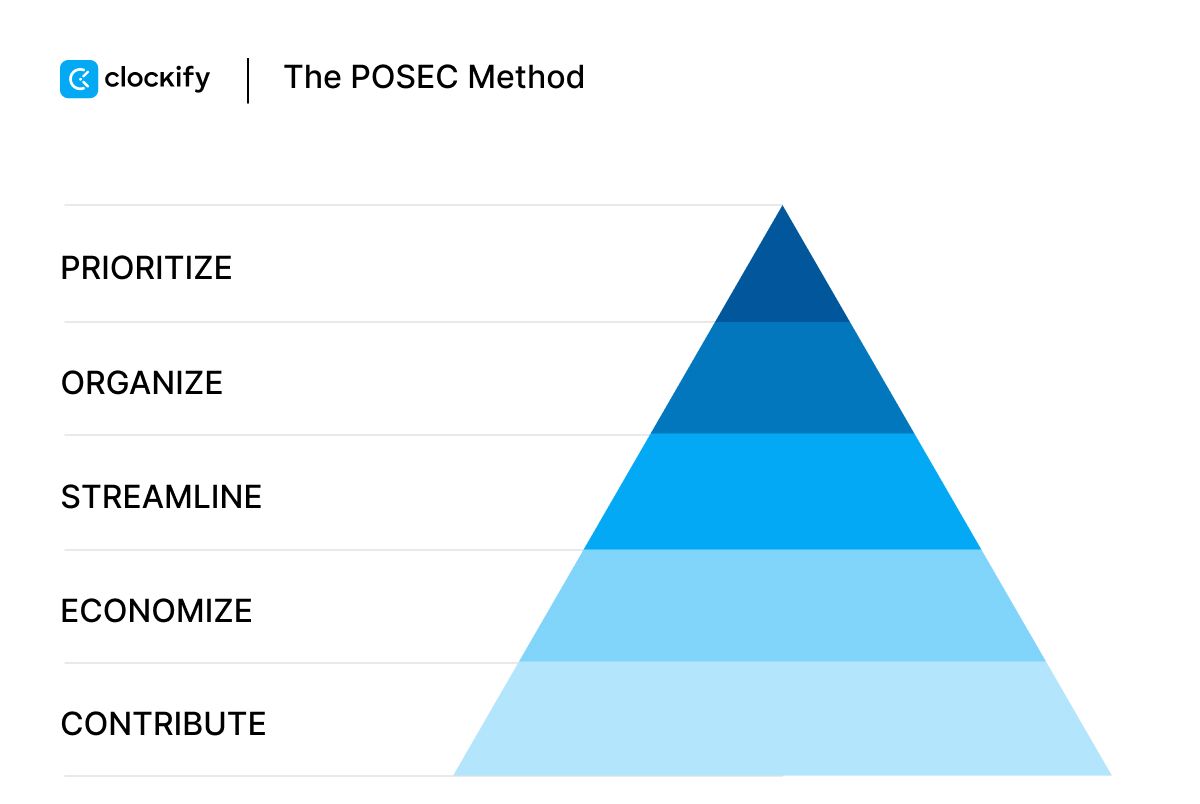
How the POSEC Method works:
- Prioritizing (goals and time): Figure out what your goals are and how much time you need to accomplish them (whether they’re long-term or short-term).
- Organizing (family and finances): Think of all activities in your personal and professional life. Aside from the activities that are related to achieving your goals, you have to keep an eye on your family’s well-being and take care of your finances.
- Streamlining (work and chores): Figure out the most efficient way to complete your work and chores. For example, try to automate as many tasks as you can.
- Economizing (hobbies and socializing): This level includes activities you enjoy, such as socializing with friends and pursuing hobbies. Sometimes, these activities don’t contribute to achieving your overall goals.
- Contributing (social obligations): Once you’ve attained all your previous levels, you can help others in your community. For instance, you can volunteer or help your friends or neighbors with a household chore.
Advantages of the POSEC Method:
- This method helps make time not only for your work-related tasks, but also for your personal activities and leisure time.
- You can use it both for long-term and short-term goals.
- You’ll get better at scheduling personal and work activities.
Disadvantages of the POSEC Method:
- It isn’t very practical for organizing your daily tasks.
- It can be time-consuming to organize your tasks using this method.
28. The Bullet Journal (BuJo) Method
Developed by digital product designer Ryder Carroll, the Bullet Journal Method requires you to use a pen and notebook.
How the BuJo Method works
The BuJo has 4 components, and each contains 2 blank pages:
- Index page — includes information about page numbers for your Future, Monthly, and Daily logs, so you can easily find all your logs.
- Future log — helps you make plans for the future. For instance, you can plan the next 6 months and add them to your Future log pages. Create a box for each month and add a month label. Here, you can add important notes, appointments, and meetings for each month.
- Monthly log — on the left page of your Monthly log, you’ll have a monthly calendar. This is where you’ll note down all the dates of the month and the first letter of each day. On the right page, you’ll have your monthly task list. Make sure to include all the essential tasks for the month here.
- Daily log — write down the day’s date. Then, add your tasks (add a dot bullet next to each one), events (add a circle bullet next to each one), and notes (add a dash bullet).
If you have some very important tasks, you can note down an S (Signifier) next to them. That way, you’ll know these are your priorities.
At the end of each month, you should review your tasks. For instance, you can delete some tasks or migrate some assignments from your Daily log to a new Monthly log.
Advantages of the Bullet Journal:
- Helps you track the past, organize the present, and plan for the future.
- It allows you to plan your tasks, events, and notes.
- You’ll have fewer chances of missing your deadlines.
Disadvantages of the Bullet Journal:
- To make an effective BuJo from scratch, you’ll need to invest time, so it won’t be quite practical if you’re a busy person.
- Even if you only need a technique to manage your tasks, this method won’t be convenient for you.
29. The 3-2-1 Rule
According to Mel Robbins, The New York Times bestselling author, the 3-2-1 Rule of time management refers to our evening routines. She believes that, if you follow this rule in the evening, you can improve productivity the next day.
How the 3-2-1 Rule of time management works:
- Don’t eat anything or drink alcohol 3 hours before bedtime,
- Don’t work 2 hours before bed, and
- Stay away from screens 1 hour before bed.
Advantages of the 3-2-1 Rule:
- When you’re well rested, you can tackle all your tasks with more focus.
- It helps reduce stress and burnout by giving you enough time to detach from work before bed.
- It improves your work-life balance.
Disadvantages of the 3-2-1 Rule:
- Even though it helps you get rest, this rule doesn’t help you set work priorities.
- It doesn’t help you organize your work tasks in any way.
30. The 60-40 Rule
In his video about the 60-40 Rule for time management, Brendon Burchard, The New York Times bestselling author, explains that we should spend:
- 60% of our time doing “needle-moving” activities — activities that move us towards our goals, and
- 40% of our time on administrative tasks.
How the 60-40 Rule works:
- At the beginning of every week, select your needle-moving activities.
- Then time-block your hours in a calendar to ensure you focus on these vital tasks.
- At the end of every week, review your calendar and consider whether you need to shift your time blocks to earlier or later periods of the day, based on your biological prime time.
Advantages of the 60-40 Rule:
- It helps reduce burnout by allowing you to dedicate more time to tasks that bring you a sense of accomplishment and reward.
- You’ll ensure you work consistently on your long-term goals.
- You’ll spend less time on meetings, emails, and similar tasks that don’t always move you towards your goals.
Disadvantages of the 60-40 Rule:
- Since you choose your needle-moving tasks at the beginning of the week, you might miss important, unexpected assignments that come up during the week.
- It can be time-consuming to plan your week this way, especially if you have a tight project deadline.
FAQs about time management
Here are answers to some commonly asked questions about time management and time management hacks.
What are time management skills?
Time management skills help us manage our personal and work lives more effectively. The most common time management skills include:
- Setting SMART goals — the goals you set for yourself should be Specific, Measurable, Attainable, Relevant, and Time-bound.
- Effective planning — have clear objectives, defined tasks, and resources so you can make a clear plan that will lead you to your goals.
- Stress management — use stress-relieving strategies and tactics to feel more relaxed while doing your work.
- Proper task delegation — delegating tasks helps you manage workload and share it with competent colleagues and employees.
- Avoiding distractions — distractions take away from the time you should be working (or even relaxing), so you should learn how to avoid them.
- Single-tasking — focusing on 1 task at a time — helps you deliver higher-quality results than multitasking.
- Saying No — this little 2-letter word will help you save more time for your own priorities.
- Setting priorities — investing time in the right tasks means less effort and better results.
- Overcoming procrastination — identify the causes of your procrastination and tackle them.
What is the most powerful time management technique?
There’s no single most powerful time management technique. In fact, you can adopt the technique that works best for you or even combine different time management methods for maximum productivity.
Co-founder and CEO of a small business, Ali Yilmaz, says he experimented with several time management techniques until he found the ideal combination:
Ali says this combo has made him “more intentional, less reactive, and noticeably more productive.”
What are the 5 P's of time management?
The 5 P’s of time management stand for:
- Prioritize — consider what tasks or activities are most important.
- Plan — organize your daily, weekly, and monthly work obligations.
- Prepare — think about possible obstacles on your way to completing assignments, and how you can overcome them.
- Pace — don’t forget to include breaks into your schedules. Also, organize your workdays according to your energy levels — leave priority tasks to your most productive hours.
- Persist — from time to time, analyze your work and your progress. This is the best way to consider how your projects are advancing.
What is the golden rule of time management?
The golden rule of time management is — time is finite, and we need to keep that in mind when organizing our work and private lives. Knowing that time is finite means you need to focus on setting your priorities in all aspects of your life.
In the words of Oliver Burkeman, in his book Four Thousand Weeks: Time Management for Mortals:
So, you need to be realistic about your tasks, decide your priorities, and stick to them. And as Burkeman says, learn to be okay with the fact that you’ll need to sacrifice some tasks or activities.
How do billionaires manage their time?
Richard Branson, the founder of the Virgin Group, manages his time by holding only standing meetings that last 5 to 10 minutes. In his opinion, the goal is to engage all meeting participants so they can reach decisions quickly.
On the other hand, Bill Gates, the co-founder of Microsoft, uses the Four Buckets time management technique. So, Gates breaks down his day into 4 buckets, each with its own goal. Additionally, you can dedicate 1 bucket to 1 project.
If you want to try this technique, you’ll need to test it for at least 3 months and then review whether it makes you more productive.
What is the best time management system?
There’s no single best time management system. It all depends on whether you want to improve your:
- Focus,
- Motivation,
- Task prioritization, or
- Scheduling.
With that in mind, you can choose the most suitable time management strategy for your needs.
How can ADHD people manage time?
This is what Dr. Tracey Marks, a psychiatrist, claims ADHD people should do to manage their time:
- Always have access to time devices — Dr. Marks recommends choosing physical clocks and watches over phones. She says, “You want your awareness of the time to be a seamless flow, because it’s always there in your face.”
- Use a planner — she suggests a daily and a weekly planner, which can be paper or digital. It’s important to keep it with you at all times so you can add all your vital tasks.
- Have a reward in mind and organize your tasks accordingly — Dr. Marks advises scheduling tasks we don’t feel like doing around our breaks. For example, if you enjoy watching the news at a certain time of day, schedule your unpleasant task before that break.
What are the different time management styles?
Time management styles are different methods we can use to overcome our own time management issues. There are 6 of them:
- Time Martyr — your own tasks feel like too much responsibility, so you jump at the chance to take on anything else. In other words, you gain validation from others, but neglect the tasks that would bring you self-validation.
- Procrastinator — you delay work on everything remotely important. Some procrastinators claim they work better under pressure, but the results they get are often dampened by the stress and anxiety this practice brings.
- Distractor — you're easily distracted. A random request from a colleague is as likely to catch your fleeting attention as is a 20-minute phone call from your proprietor.
- Underestimator — you estimate that handling a task will take you much less than it actually does; you rarely live up to your optimistic deadlines.
- Firefighter — you try to tackle everything on your own, right now; you’re constantly putting out “fires” left and right, and don't feel fulfilled unless you’re working on 10 tasks at once, and feeling “busy.”
- Perfectionist — you want everything to be perfect. You’ll work overtime, and invest all your efforts into delivering a high-quality project — but you often don't know how to quit while you're ahead, so you may miss your deadlines and risk burnout.
So, the next time you realize you still haven’t completed an important project, reconsider your time management style. For example, if you’re a Perfectionist, you might deal with project cost overruns simply because you’re trying to make everything perfect while neglecting your budget limits.
Track your team’s time effectively with Clockify
If you track employee work hours using spreadsheets, you probably know how tedious it can be — not to mention the time lost fixing errors.
As a reliable timekeeping tool, Clockify allows project and operations managers to:
- Track time spent on tasks and projects accurately and efficiently,
- Monitor project progress in real time, and
- Generate transparent time reports for billing.
In Clockify’s reports, you can see all the billable time tracked on your projects (and the amounts earned) — and analyze the data in more detail. With these insights, you can:
- Assess your team’s efficiency,
- Identify and eliminate bottlenecks,
- Avoid scope creep,
- Prevent cost overruns, and
- Ensure the project is delivered within budget.

In fact, you can compare the estimated and the actual budget spent on projects. This helps you improve future project estimations.
You can set a project budget and track how much of the budget has been spent in Clockify.
Essentially, Clockify helps project managers:
- Track where your team’s time goes,
- Optimize resources,
- Identify profitable and unprofitable projects, and
- Make smarter decisions that drive business growth.
If you need help using the app, Clockify offers free, full human customer support available 24/7.
And if you want to maximize your team’s productivity, check out the CAKE.com Productivity Bundle.
With this suite, you get 3 business tools for the price of 1:
- Clockify — a reliable time tracker,
- Plaky — a simple task management tool, and
- Pumble — an all-in-one team communication app.




